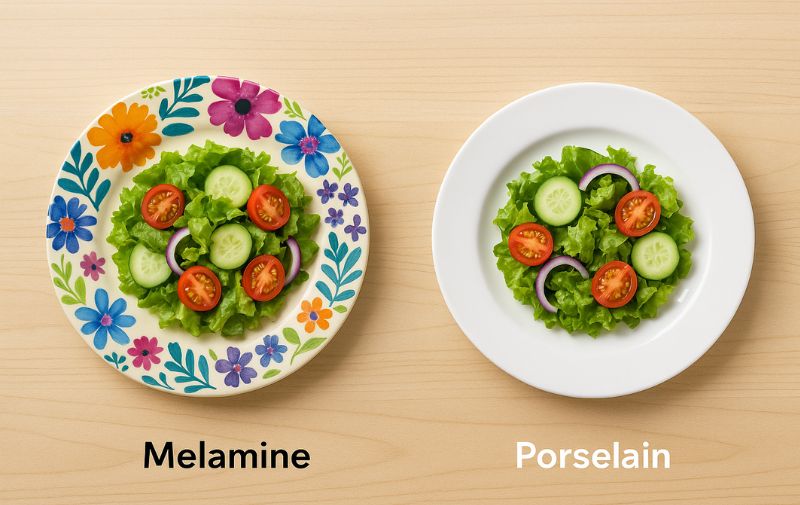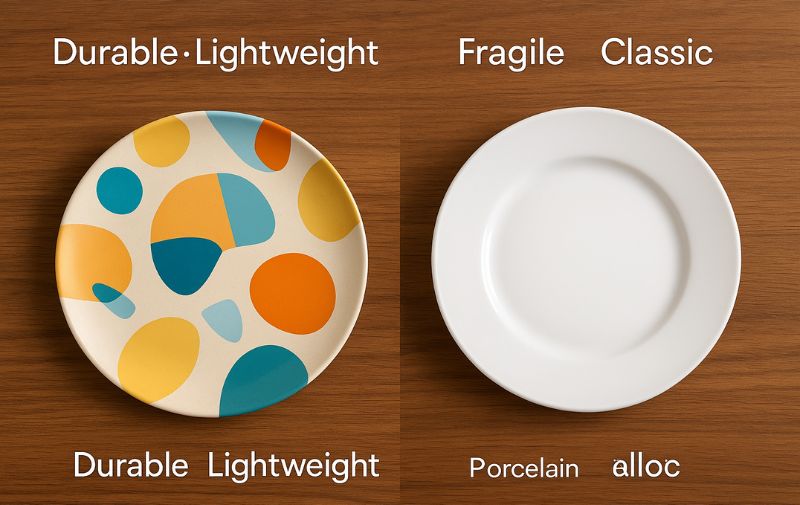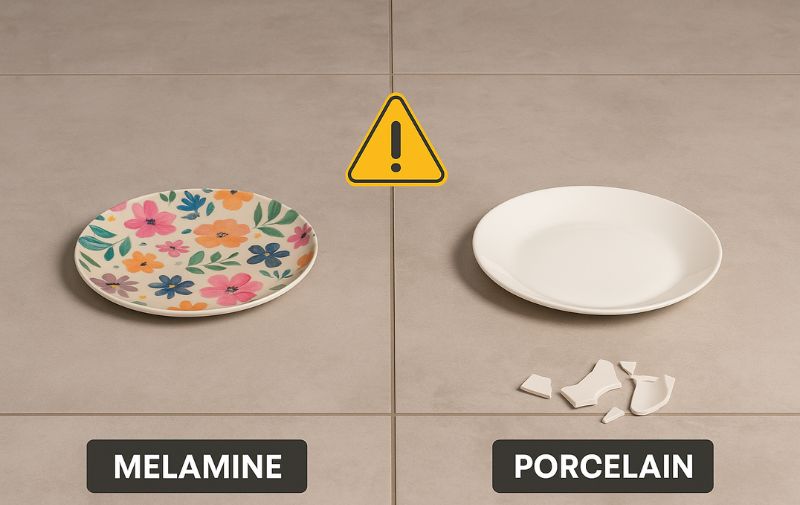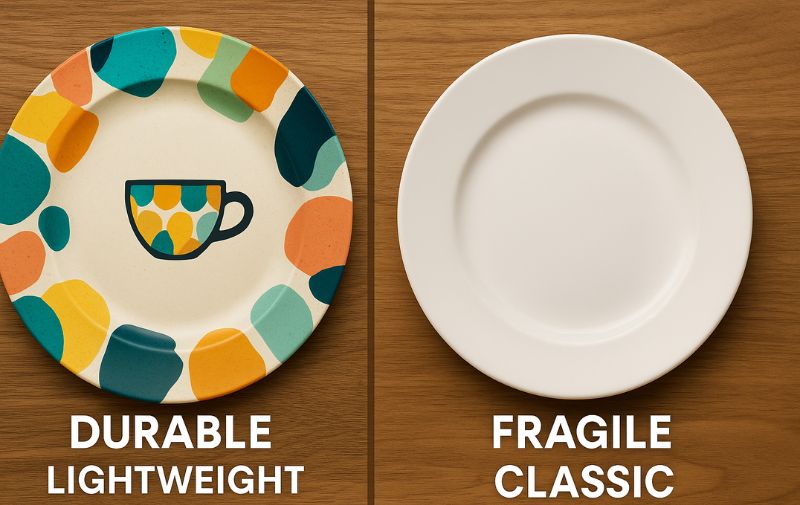Choosing new dinnerware can be exciting, but with options like melamine plates vs. porcelain, how do you decide what’s best for your table? Both offer unique advantages, but understanding the difference between melamine and porcelain is key. Melamine offers exceptional, nearly unbreakable durability – ideal for busy families or outdoor dining. Porcelain provides classic, elegant style, easy to breakable.
This guide directly compares them, helping you discover which material truly suits your everyday needs and special occasions.
Last Updated: May 2025 | Estimated Reading Time: 9 minutes

What Exactly Are Melamine and Porcelain Plates Made Of?
Before diving into the comparison, let’s understand the basic composition of these popular dinnerware materials.
How can you identify melamine dinnerware, and what is its basic composition?
Melamine dinnerware is crafted from melamine-formaldehyde resin, a type of durable, thermosetting plastic. You can often identify it by its lightweight feel compared to ceramic or porcelain, and its characteristic dull “thud” if tapped or dropped, rather than a sharp “clink.” 🍽️
- Composition: High-quality melamine, like A5 grade (100% food-grade melamine), is specifically formulated for food contact, ensuring it’s safe and robust for serving meals, including hot food (typically up to 70°C-100°C / 158°F-212°F for serving).
- Feel: It’s relatively warm to the touch.
What are the general characteristics of porcelain as a dinnerware material?
Porcelain is a ceramic material made by heating specific raw materials, generally including kaolin (a type of clay), in a kiln to temperatures between 1,200 °C (2,192 °F) and 1,400 °C (2,552 °F).
- Characteristics: It’s known for its strength, translucency (in finer grades like bone china), and non-porous nature. Porcelain often has a more delicate, refined appearance and a heavier, denser feel than melamine.
- Feel: It’s generally cool to the touch.
Durability Showdown: Which Plate is Tougher?
When it comes to everyday bumps and drops, there’s a clear winner in the melamine vs. porcelain dinnerware durability contest.

How does the durability of melamine plates compare to traditional materials?
Melamine plates boast exceptional durability, far surpassing traditional materials like porcelain or ceramic in terms of impact resistance. This is a primary reason for their popularity. Industry Insight: This isn’t just about avoiding a broken plate. For businesses like restaurants or caterers, and even busy households, this dramatically reduces replacement costs over time. The peace of mind knowing a dropped plate won’t shatter is invaluable.
What makes melamine celebrated for being “nearly unbreakable”?
Melamine’s plastic resin composition gives it a high resistance to chipping, cracking, and shattering when dropped. While not entirely indestructible (a severe impact or deliberate force can damage it), it withstands typical household and commercial mishaps remarkably well. This makes melamine durability a standout feature.
How does porcelain typically fare in terms of breakability and chipping?
Porcelain, while strong for a ceramic, is inherently more fragile than melamine.
- Breakability: It can break if dropped onto a hard surface.
- Chipping: Edges can chip with impact, especially in dishwashers or if knocked against other hard objects. Even high-quality porcelain durability has its limits against sudden impacts.
📊 Durability at a Glance – Melamine vs. Porcelain 📊
| Feature | Melamine Plates | Porcelain Plates | Your Benefit |
|---|---|---|---|
| 💥 Impact Resistance | Very High (Nearly Unbreakable) | Moderate to Low (Can break/chip) | Fewer replacements, safer for kids/outdoor. |
| 💪 Chip Resistance | High | Moderate (Prone to edge chipping) | Plates look newer for longer. |
| 💔 Shatterproof | Yes | No | Safer if dropped, less mess. |
| 🏋️ Weight | Lightweight | Heavier | Easier to handle, especially in stacks or by kids. |
| 💰 Replacement Cost | Low (due to durability) | Higher (due to breakage) | Long-term savings. |

Style and Aesthetics: Casual Charm vs. Fine Elegance? 🎨
The look and feel of your dinnerware contribute significantly to your dining experience.
What kind of aesthetic is melamine dinnerware generally associated with?
Melamine dinnerware is often associated with:
- Casual and relaxed dining: Perfect for everyday meals, outdoor gatherings, and families.
- Vibrant colors and patterns: It offers unparalleled versatility in design, from solid brights to intricate, full-surface custom prints.
- Modern finishes: Available in gloss, matte, or even textured surfaces that can mimic stone or wood.
Industry Insight: High-quality A5 melamine can convincingly mimic the look of ceramic, stoneware, or even fine porcelain, including details like speckles or rustic edges. This allows for a desired aesthetic combined with superior melamine durability.
When is porcelain considered “hard to beat” in terms of dining experience?
Porcelain is often “hard to beat” for:
- Formal dining and special occasions: Its classic elegance lends a sophisticated touch.
- Fine dining restaurants: The traditional choice for a premium feel.
- Traditional and minimalist styles: White porcelain, in particular, offers a timeless, clean aesthetic.
Are there differences in the finish or feel between melamine and porcelain?
Yes, distinct differences exist:
- Feel: Melamine feels slightly warmer and lighter. Porcelain has a cooler, denser, and often smoother (more vitreous) feel.
- Sound: Cutlery on melamine produces a duller, quieter sound. On porcelain, it creates a distinct, higher-pitched “clink,” often associated with a more formal experience.
- Finish: Melamine can have a wider range of finishes and textures. Porcelain typically has a smooth, glazed finish, though matte glazes are also available.
Practicality and Use Cases: When to Choose Which?
The best choice between melamine plates vs. porcelain often comes down to how and where you’ll be using them.
For what types of dining occasions is melamine dinnerware considered ideal?
Melamine dinnerware is ideal for:
- Outdoor dining: Picnics, BBQs, patio parties, boating, and RVs due to its lightness and durability. This makes outdoor dinnerware melamine porcelain comparisons lean heavily towards melamine.
- Households with children: Its “nearly unbreakable” nature makes it a safe and practical option for little ones. A top choice when considering kid-friendly plates melamine porcelain.
- Casual everyday meals: For breakfast, lunch, and relaxed dinners.
- High-traffic environments: Schools, hospitals, cafeterias, and busy restaurants where breakage is a concern.
Industry Insight: The lighter weight of melamine is a significant practical advantage. It reduces staff fatigue in commercial settings and makes it easier for children and the elderly to handle. Lower weight also translates to lower shipping costs for bulk B2B orders.
Why is melamine a practical option for households with children or for outdoor dining?
Its resistance to breaking and chipping means fewer worries about accidents, injuries from sharp shards, or the cost of replacing broken plates. Its light weight also makes it easy for kids to carry their own plates.
In what settings does porcelain dinnerware typically excel?
Porcelain dinnerware excels in:
- Formal dinner parties.
- Holiday meals and special celebrations.
- Fine dining restaurants seeking a traditional, upscale ambiance.
- Any setting where the elegance and classic feel of formal dinnerware porcelain are desired.
💡 Practical Use Cases – Which Material Shines Where? 💡
| Dining Scenario | Melamine Plates Suitability (A5 Grade) | Porcelain Plates Suitability | Why? |
|---|---|---|---|
| 👨👩👧👦 Kids & Family Meals | ⭐⭐⭐⭐⭐ (Excellent) | ⭐⭐ (Fair) | Durability, lightweight, less worry about breakage. |
| 🧺 Outdoor Picnics/BBQs | ⭐⭐⭐⭐⭐ (Excellent) | ⭐ (Poor) | Lightweight, unbreakable, easy to transport. |
| 🎉 Casual Get-Togethers | ⭐⭐⭐⭐ (Very Good) | ⭐⭐⭐ (Good) | Versatile designs, practical, less formal. |
| 🍽️ Formal Dinner Parties | ⭐⭐ (Fair, if high-quality mimic) | ⭐⭐⭐⭐⭐ (Excellent) | Traditional elegance, premium feel. |
| ♨️ Serving Hot Food | ⭐⭐⭐⭐ (Very Good – up to 100°C) | ⭐⭐⭐⭐⭐ (Excellent) | Melamine insulates; Porcelain handles heat well (oven/microwave safe). |
| 🔥 Reheating in Microwave | ❌ (Unsafe) | ✅ (Generally Safe) | Melamine degrades; Porcelain withstands microwave heat. |
| 🧼 Dishwasher Safety | ✅ (Top-rack often best) | ✅ (Generally Safe) | Both are generally safe, but check manufacturer advice. |
Variety and Versatility: What Options Do You Have?
Both materials offer a wide array of choices, but with some key differences.
Is melamine limited to just plates, or are other types of dinnerware available?
Melamine is far from limited to just plates! You can find a vast range of melamine dinnerware, including:
- Bowls (cereal, soup, salad)
- Cups and Mugs
- Serving platters and trays
- Utensils
- Kids’ dinnerware sets (often with fun shapes and characters)
- Deep dinner plate sets and tray sets
Industry Insight (B2B Customization): For businesses, melamine offers a significant advantage. Manufacturers like Duramela can facilitate custom molds (with an initial investment) and offer thousands of print designs on existing shapes with flexible Minimum Order Quantities (MOQs). This is invaluable for branding (hotels, restaurants with logos), themed collections, or OEM clients developing unique product lines.
This level of cost-effective, intricate customization is harder and more expensive to achieve with porcelain.
What kind of product range can you typically find in porcelain dinnerware?
Porcelain also offers a comprehensive range:
- Dinner plates, salad plates, bread plates
- Bowls of various sizes
- Tea and coffee sets (cups, saucers, teapots)
- Serving dishes and tureens
- Specialty items like ramekins and au gratin dishes
While custom surface decoration is possible on porcelain, unique shapes are significantly more costly and demand very high MOQs compared to melamine.
Considering the Cost: What’s the Price Difference? 💰
The melamine cost vs. porcelain cost can vary widely based on quality, design, and brand.
How does the cost of melamine dinnerware generally compare to other options?
Generally, melamine dinnerware offers a lower initial purchase price compared to many porcelain options, especially for patterned, colorful, or large sets. This makes it an attractive choice for budget-conscious consumers or those needing large quantities.
Industry Insight (Total Cost of Ownership): The true financial advantage of melamine, especially in high-volume settings like restaurants or schools, is its lower “total cost of ownership.” Due to its extreme melamine durability, the frequency of replacements is drastically lower than porcelain. Over a few years, this leads to substantial savings.

Can the price of porcelain vary significantly based on quality and craftsmanship?
Yes, the price of porcelain can range dramatically:
- Basic stoneware or everyday porcelain: Can be quite affordable and comparable to some melamine.
- Fine china and bone china: Significantly more expensive due to material quality, intricate designs, and brand reputation.
- Artisan-crafted porcelain: Can be very costly due to unique craftsmanship and limited production.
Key Differences at a Glance: Melamine vs. Porcelain
Let’s summarize the main points in a comprehensive comparison.
📊 Feature Comparison – Melamine vs. Porcelain 📊
| Feature | Melamine Plates (A5 Grade) | Porcelain Plates | Key Takeaway for You |
|---|---|---|---|
| 🧱 Primary Material | Melamine-formaldehyde resin (thermosetting plastic) | Fired Kaolin clay & other minerals (ceramic) | Different base materials lead to different properties. |
| 💪 Durability | ⭐⭐⭐⭐⭐ (Highly chip, crack, shatter-resistant) | ⭐⭐⭐ (Can chip, crack, break with impact) | Melamine is much tougher for everyday accidents. |
| 🏋️ Weight | Lightweight | Heavier | Melamine is easier to handle, carry, and stack. |
| ✨ Aesthetics | Casual, vibrant, versatile designs, can mimic other materials | Classic, elegant, traditional, fine dining feel | Choose based on your desired style and occasion. |
| 🎨 Design & Color Options | ⭐⭐⭐⭐⭐ (Extensive, intricate patterns, custom prints easy) | ⭐⭐⭐⭐ (Wide range, but complex custom can be costly) | Melamine offers more cost-effective and diverse design freedom. |
| 🔥 Heat Resistance (Serving) | Good for hot food (up to 70-100°C / 158-212°F) | Excellent (can handle very hot food) | Both are fine for serving typical hot meals. |
| ♨️ Microwave Safe | ❌ NO | ✅ YES (Generally) | Porcelain is suitable for reheating; NEVER microwave melamine. |
| 🔥 Oven Safe | ❌ NO | ✅ YES (Generally, check manufacturer) | Porcelain offers more cooking/reheating versatility. |
| 🧼 Dishwasher Safe | ✅ YES (Top-rack often recommended) | ✅ YES (Generally) | Both are easy to clean, but porcelain can chip if items knock. |
| 👧 Kid-Friendly | ⭐⭐⭐⭐⭐ (Excellent – safe & durable) | ⭐⭐ (Fair – risk of breakage) | Melamine is a top choice for families with young children. |
| 🏕️ Outdoor Use | ⭐⭐⭐⭐⭐ (Excellent – lightweight & durable) | ⭐ (Poor – heavy & breakable) | Melamine is ideal for picnics, BBQs, and patio dining. |
| 💰 Initial Cost | Generally Lower | Varies Widely (can be higher) | Melamine often offers better upfront value. |
| 🔄 Long-Term Cost | Lower (due to fewer replacements) | Potentially Higher (due to breakage) | Melamine’s durability can save you money over time. |
| 🌿 Sustainability | Durable (long life), recycling specialized. Bamboo-melamine blends offer renewable component. | Natural materials, energy-intensive production. Broken pieces to landfill. | Complex picture; longevity is a plus for melamine. |
Which material offers more advantages for casual dining and outdoor activities specifically?
Melamine clearly offers more advantages for casual dining and outdoor activities. Its superior durability, lightweight nature, vibrant design options, and lower risk of breakage make it the more practical and worry-free choice for these settings. If you’re looking for outdoor dinnerware melamine porcelain comparisons, melamine almost always comes out on top for practicality.
Expert Care Tips & Considerations:
- Melamine Care: While dishwasher safe (top-rack is often gentlest on prints), avoid abrasive scrubbers. For stubborn stains (rare on A5 quality), a paste of baking soda and water can help. Serrated knives can scratch melamine over time.
- Porcelain Care: Be mindful of “thermal shock” – avoid drastic temperature changes (e.g., refrigerated plate into a hot oven) as it can cause cracking. Though dishwasher safe, careful loading prevents chipping.
- Quality Matters: For melamine, always opt for A5 grade (100% food-grade melamine) from reputable manufacturers. Cheaper, lower-grade melamine (e.g., A1 with fillers) may not offer the same durability, heat resistance, or safety.
Frequently Asked Questions (FAQ)
Q1: Is melamine completely unbreakable?
While highly durable and resistant to shattering, melamine is not 100% unbreakable. Extreme force or a very awkward drop can still cause damage, but it’s far more resilient than porcelain.
Q2: Can you use sharp knives on melamine plates?
You can, but prolonged use of very sharp or serrated knives can eventually cause superficial scratches on melamine surfaces. For daily use with regular cutlery, it holds up well.
Q3: What is A5 melamine, and why is it important?
A5 melamine refers to 100% food-grade melamine resin. It’s the highest quality, ensuring better durability, heat resistance for serving hot food, and the lowest potential for chemical migration, making it the safest choice for dinnerware.
Q4: Is porcelain always better for formal occasions?
Traditionally, yes. However, modern high-quality A5 melamine can offer very sophisticated designs that mimic fine ceramics, making it a viable and practical alternative for less formal “special” occasions, especially if durability is a concern.
Q5: Between melamine vs porcelain dinnerware, which lasts longer?
If we’re talking about resistance to breaking, melamine will typically “last longer” in an environment prone to accidents. Porcelain, if carefully handled, can last for generations but is always at risk of chipping or breaking. The usable lifespan depends heavily on use and care.
So, Melamine or Porcelain: What’s Your Ideal Match?
Ultimately, the choice between melamine plates vs. porcelain depends on your lifestyle, priorities, and how you plan to use your dinnerware.
- Choose Melamine if: You prioritize durability, have young children, frequently dine outdoors, want vibrant and varied designs, or are looking for a cost-effective solution with a low total cost of ownership. It’s perfect for casual, everyday use where practicality and resilience are key.
- Choose Porcelain if: You prefer a traditional, elegant aesthetic for formal dining, require oven or microwave safe dinnerware, and value the classic feel and weight of ceramic. It’s ideal for special occasions and settings where a premium ambiance is desired.
By understanding these differences, you’re now equipped to select the dinnerware material that will best serve your needs and bring enjoyment to your meals for years to come!
Recommended Internal & External Links:
- Wikipedia – Melamine Resin (General information on the material)
- Wikipedia – Porcelain (General information on the material)
- British Plastics Federation – Melamine FAQs (Search for melamine resources on authoritative plastics industry sites for general consumer info)



